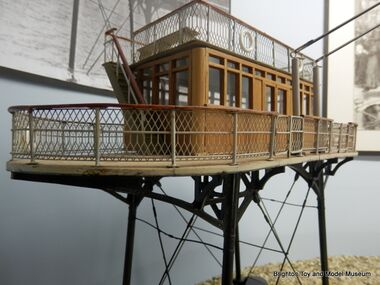Category:Brighton and Rottingdean Seashore Electric Railway
"A Sea Voyage on Wheels" - original poster for the Brighton and Rottingdean Seashore Electric Railway) [image info]
An accurate model of the Daddy Long-Legs' "Pioneer" car, on loan to the Museum [image info]
The Brighton and Rottingdean Seashore Electric Railway (a.k.a. the "Daddy Long-Legs") was a seagoing electric railway designed by inventor Magnus Volk that briefly ran along a section of Brighton coastline, linking Brighton's existing Volks Electric Railway with Rottingdean.
Concept
The aim of the railway was to extend the reach of the existing Volk's Electric Railway eastward. Since the eastern section of coast ran out of seafront, and quickly ended up with cliffs that were directly against the sea, Volk was confronted with the intimidating and costly prospect of an expensive project to build the railway extension onto the cliff-face.
Volk's solution was instead to build the railway out at sea, with the electrically-powered car built on four cross-braced stilted legs that kept the passenger section well above sea-level, and to also build a special alighting-platform at Rottingdean.
"Pioneer"
The railway's only car, the Pioneer, was a cross between an electric tram and a mobile section of pier. Its engineer was R. St.George Moore, who went on to design the Palace Pier.
Th Pioneer picked up its power from an electrical overhead cable, which powered four electrical motors fixed to the underside of the car's main platform. These powered rotating driveshafts built into the hollow cylindrical legs, which in turn powered the wheels via bevel gears.
For stability, each of the the Pioneer's four legs sat on top of a shrouded, weighted pugs, with the left- and right-hand sets of pugs each having their own two-rail track.
History - construction and destruction
Construction started in June 1894, and the railway was opened in late November 1896.
After the railway had only been open for a couple of weeks, a a particularly vicious storm in early December 1896 (which also completely destroyed the Chain Pier) wrecked the Daddy Long-Legs’ landing stage and overturned the car. Volks managed to get the line and infrastructure rebuilt and the railway reopened in July 1897.
However, The Brighton Corporation then decided that Brighton's sea defences needed to be strengthened, and started work in January 1901 on extending the set of "groynes" that provided the Brighton region's coastline with some protection from erosion. Groynes are walls that extend out to sea to slow the sideways drift of sand or pebbles, and these new barriers intersected the railway track.
That was the end of the railway, and the railway's single car, Pioneer, was eventually sold for scrap in 1910.
External Links
- Volk's Brighton to Rottingdean Seashore Electric Railway
- "The Brighton & Rottingdean Seashore Electric Railway", Volks Electric Railway Association
|
i360 – West Pier – Palace Pier – Chain Pier – Volks Railway – Daddy Long-Legs – Brighton Marina |
Pages in category ‘Brighton and Rottingdean Seashore Electric Railway’
The following 4 pages are in this category, out of 4 total.
Media in category ‘Brighton and Rottingdean Seashore Electric Railway’
The following 8 files are in this category, out of 8 total.
- A Railway on Stilts 01, Brighton Rottingdean Seashore Electric Railway (RWW 1935).jpg 2,500 × 1,574; 2.88 MB
- A Railway on Stilts 02, Brighton Rottingdean Seashore Electric Railway (RWW 1935).jpg 2,500 × 1,684; 2.86 MB
- Brighton and Rottingdean Seashore Electric Railway poster.jpg 814 × 1,200; 436 KB
- Daddy Long Legs.jpg 1,024 × 768; 260 KB
- Rottingdean Beach looking West, postcard (Celesque B42787 m1911).jpg 3,000 × 1,875; 4.14 MB
- The Career of Magnus Volk (1851-1937), Meccano Magazine.jpg 2,449 × 1,648; 982 KB
- Volk's Daddy-Long-Legs and alighting platform, Meccano Magazine 1937.jpg 1,301 × 877; 231 KB
- Volk's Daddy-Long-Legs and track, Meccano Magazine 1937.jpg 1,289 × 901; 298 KB












